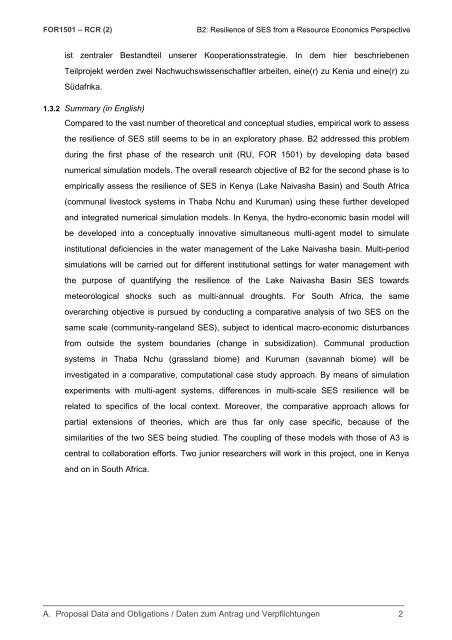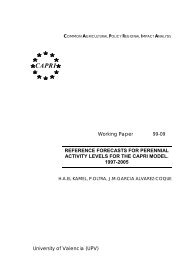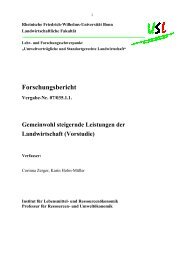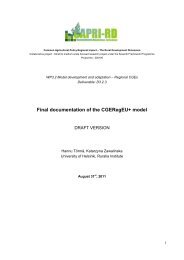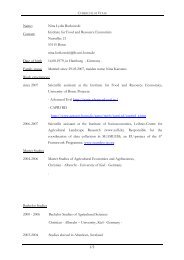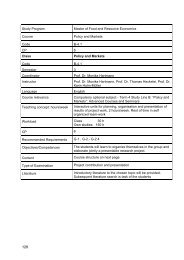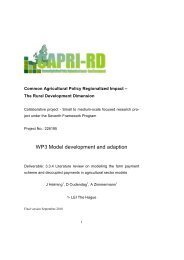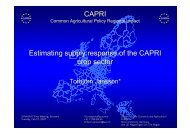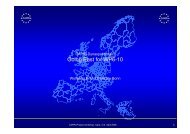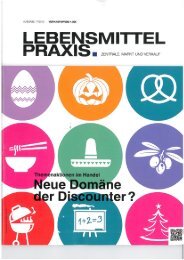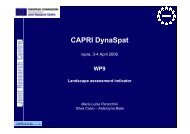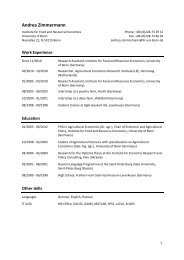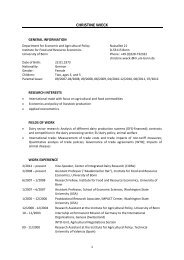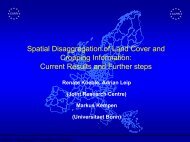Research proposal of sub-project B2 for second phase - Institut für ...
Research proposal of sub-project B2 for second phase - Institut für ...
Research proposal of sub-project B2 for second phase - Institut für ...
Create successful ePaper yourself
Turn your PDF publications into a flip-book with our unique Google optimized e-Paper software.
FOR1501 – RCR (2)<br />
<strong>B2</strong>: Resilience <strong>of</strong> SES from a Resource Economics Perspective<br />
ist zentraler Bestandteil unserer Kooperationsstrategie. In dem hier beschriebenen<br />
Teilprojekt werden zwei Nachwuchswissenschaftler arbeiten, eine(r) zu Kenia und eine(r) zu<br />
Südafrika.<br />
1.3.2 Summary (in English)<br />
Compared to the vast number <strong>of</strong> theoretical and conceptual studies, empirical work to assess<br />
the resilience <strong>of</strong> SES still seems to be in an exploratory <strong>phase</strong>. <strong>B2</strong> addressed this problem<br />
during the first <strong>phase</strong> <strong>of</strong> the research unit (RU, FOR 1501) by developing data based<br />
numerical simulation models. The overall research objective <strong>of</strong> <strong>B2</strong> <strong>for</strong> the <strong>second</strong> <strong>phase</strong> is to<br />
empirically assess the resilience <strong>of</strong> SES in Kenya (Lake Naivasha Basin) and South Africa<br />
(communal livestock systems in Thaba Nchu and Kuruman) using these further developed<br />
and integrated numerical simulation models. In Kenya, the hydro-economic basin model will<br />
be developed into a conceptually innovative simultaneous multi-agent model to simulate<br />
institutional deficiencies in the water management <strong>of</strong> the Lake Naivasha basin. Multi-period<br />
simulations will be carried out <strong>for</strong> different institutional settings <strong>for</strong> water management with<br />
the purpose <strong>of</strong> quantifying the resilience <strong>of</strong> the Lake Naivasha Basin SES towards<br />
meteorological shocks such as multi-annual droughts. For South Africa, the same<br />
overarching objective is pursued by conducting a comparative analysis <strong>of</strong> two SES on the<br />
same scale (community-rangeland SES), <strong>sub</strong>ject to identical macro-economic disturbances<br />
from outside the system boundaries (change in <strong>sub</strong>sidization). Communal production<br />
systems in Thaba Nchu (grassland biome) and Kuruman (savannah biome) will be<br />
investigated in a comparative, computational case study approach. By means <strong>of</strong> simulation<br />
experiments with multi-agent systems, differences in multi-scale SES resilience will be<br />
related to specifics <strong>of</strong> the local context. Moreover, the comparative approach allows <strong>for</strong><br />
partial extensions <strong>of</strong> theories, which are thus far only case specific, because <strong>of</strong> the<br />
similarities <strong>of</strong> the two SES being studied. The coupling <strong>of</strong> these models with those <strong>of</strong> A3 is<br />
central to collaboration ef<strong>for</strong>ts. Two junior researchers will work in this <strong>project</strong>, one in Kenya<br />
and on in South Africa.<br />
A. Proposal Data and Obligations / Daten zum Antrag und Verpflichtungen 2


